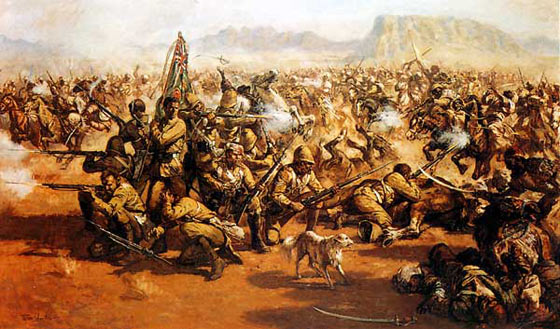66th Foot at the Battle of Maiwand in 1880.
“Maiwand: Saving the Guns”. Royal Horse Artillery withdrawing from Afghan attack at the Battle of Maiwand, painted by Richard Caton Woodville
Ferocity is an extremely respected personal attribute in the formidable warrior traditions of the Afghan tribes. The Soviet Red Army found that out during ten years of irregular and asymmetrical combat in Afghanistan. And as we shall see they were not the first outside power to encounter the perils of this Afghan way of war. A century earlier the British had a similarly wretched experience and chronicled what they endured for others to read.
As warriors, the Afghan Pathans possessed a ferocious martial temperament and highly developed irregular concepts of warfare. Their warrior tradition was already legendary in Central Asia long before London decided in the summer of 1839 to send a British Army of 15,500 soldiers, many of whom were native recruits, through the Khyber Pass from India to extend British power into Afghanistan.
The decision to deploy that expeditionary force came from those in the British government who sought to expand the frontier of the British Empire beyond India. For the British it was part of their Forward Policy to keep the Russians at bay in Southwest Asia. The intention was to send a signal to the Russian czar and to subdue another native region. The results were horrific. Three years of bitter protracted warfare culminated in the January 1842 decision to withdraw what was left of the British legion from Kabul back to India. That decision played right into the hands of the Pathan warriors and their unconventional approach to warfare. They cut the legion to ribbons. Only one man-the unit’s surgeon-made it out. It was one of the most crushing defeats in British military history.
The debacle of the First Afghan War was not enough to prevent London from remaining committed to its Forward Policy of imperial expansion through domination and direct rule. Although the British could not but recognize that the Pathans were a much greater challenge than they had thought, the British had not rethought their approach when they returned forty years later. Instead, they simply narrowed the effort-focusing on controlling the major cities in the deserts and lowlands. Although this more limited approach met with some success, British Forward Policy was hard to implement against the mountain redoubts of the Pathans.
The Second Afghan War turned into a protracted and irregular struggle of interminable skirmishes, raids, and ambushes that left scores of British soldiers wounded or dead in the Afghan mountains. In these engagements the Pathans proved to be fanatical warriors whom the British soldiers came to respect for their fighting qualities. It was those ferocious fighting attributes that prevented the British from achieving anything close to decisive control in Afghanistan. And it was from these encounters that Kipling drew his chilling descriptions of the Pathan.
Although the Forward Policy was more successful in the Peshawar Valley, the Pathans remained incorrigible and continued to rebel. While those years in Afghanistan have been called part of ‘The Great Game,’ on the ground it was a brutal fight in which the British sought to assert their power and establish supremacy. The Pathans, however, who were fighting to regain their autonomy, made it brutally clear that they were not playing the game by British rules.
The situation came to a head at the battle of Maiwand, where the British suffered another thrashing at the hands of the Pathans. In July 1880, a British/Indian force of 2,500 left Kandahar in order to put down a rebellion by Ayub Khan, the ruler of Herat. Ayub sought to overthrow the Amir of Afghanistan, a protégé of the British. The operational plan called for the British brigade to hook up with a force of 6,000 tribesmen, thought to be friendly. They turned out to be quite the opposite. The entire force ditched the British and threw in their lot with Ayub Kahn, considerably enlarging the rebel army that would fight at Maiwand to 25,000. The battle and its aftermath was another bloodbath. The British force of 2,500 suffered nearly 1,000 dead and another 200 wounded. For Ayub Kahn the casualties were much higher. It took him a week to clear the battlefield of the corpses of his regular troops and of the Ghazis, irregular tribesmen who were described as religious fanatics who fought fiercely. Ayub left more than 5,000 dead and another 1,500 wounded behind at Maiwand.
For the remainder of the British brigade there was more disaster to follow as it began a 45-mile retreat back to Kandahar. Every step of the way the Ghazis relentlessly cut down one British soldier after another. Kipling may have been thinking about this bloody retreat when he wrote those lines from ‘The Young British Soldier.’
This catastrophe finally caused London to abandon its northern frontier Forward Policy of domination and occupation and adopt the less ambitious Close Border Policy of accommodation and indirect rule. As a result, the Afghan tribes saw the British in a much less threatening light-they were no longer occupiers trying to dominate and therefore deserving of violent expulsion. Moreover, since tribal lands were no longer under threat and London took pains to avoid involvement in Afghanistan’s never-ending internal power struggles, life became much easier for the young British soldier.
